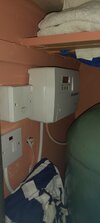Clearly now down to the installer to correct, he tried to say the nice picture showing how the power is being handled it from a server in china and has a large sampling time, so is only approximate, however the readings on the top of same page are local, so this
View attachment 314168 is reasonably accurate as to how much is transferred. The figures shown are rather messed up due to power being switched off to work on the system on that day, however he says the decision on if we need more battery capacity should be based on those readings.
However until the iboost+ is working as wanted, we don't know how much excess we will have each day, today for example there has been no feed in energy all day, and battery still only 5% charged, and this with iboost+ switched off. But some days seen 9 kWh exported.
I think I may have made a mistake getting solar panels fitted, we were told before fitting around 6 years to break even, but today the figures I have recorded show more like 12 years.
OK we now have battery back up which likely will run our freezers for weeks in the event of a power outage, although very little else, so now no need for a generator as back up, but £800 would have bought a generator, not £11k. So beginning to think maybe not the right move?


